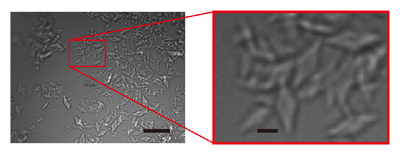Journal:Acta Cryst F:S2053230X21008967
From Proteopedia

Microcrystal preparation for serial femtosecond X-ray crystallography of bacterial copper amine oxidaseTakeshi Murakawa, Mamoru Suzuki, Toshi Arima, Michihiro Sugahara, Tomoyuki Tanaka, Rie Tanaka, So Iwata, Eriko Nango, Kensuke Tono, Hideyuki Hayashi, Kenji Fukui, Takato Yano, Katsuyuki Tanizawa, and Toshihide Okajima [1] Molecular Tour Visualization of enzymatic catalysis as molecular movies may be an ultimate goal for enzymologists. However, the direct observation of structural changes associated with the ongoing reaction has been a difficult task until recently. A new method called ‘Serial Femtosecond Crystallography (SFX)’, in which protein microcrystals delivered continuously are irradiated with ultrahigh-intensity X-ray pulses produced from X-ray free-electron lasers (XFELs), is expected to be a clue for achieving such a goal. Because diffraction data can be collected before the crystals suffer from radiation damage, SFX allows the determination of X-ray damage-free structures at room temperature. The femtosecond duration of X-ray pulses is also advantageous for visualizing rapid structural changes associated with protein action. However, preparation of high-quality microcrystals with uniform size has been a bottleneck for widespread application of SFX that consumes plenty of microcrystals. This paper reports a convenient method for production of uniform, high-quality microcrystals by combining micro-seeding and batch methods. The objective protein we used is a quinoprotein metalloenzyme, copper amine oxidase from Arthrobacter globiformis (AGAO), for which high-resolution X-ray and neutron crystal structures have already been determined at cryogenic temperatures. The first X-ray-damage-free AGAO structure determined at room temperature by SFX (PDB ID: 7f8k) is herein reported. had almost the same conformation as those determined previously by synchrotron X-ray and neutron crystallography performed at cryogenic temperature. AGAO functions as a dimer, but in the crystals obtained in this study, the unit cell contained the monomer of AGAO (shown in a green ribbon model) in the asymmetric unit. The counter subunit forming the dimer is also shown as a royal blue trace model. The electron-density map in the active site clearly showed the resting form of . In addition, the that are located at positions identical to those determined by the previous studies. The assigned stick models are shown for residue 382 (TPQ) and the Cu2+ and Cu2+-ligands (His431, His433, His592, Wax, and Weq), in which Wax and Weq are the axially and equatorially Cu2+-coordinating water molecules, respectively. These results show that the bound Cu2+ in AGAO is resistant to X-ray photoreduction, which is accompanied by conformational changes of the metal coordination structure. The availability of high-quality microcrystals in large quantities is promising for studying the structural changes of AGAO during the catalytic reaction by the ‘mix-and-inject’ time-resolved SFX. PDB reference: room-temperature structure of bacterial copper amine oxidase determined by serial femtosecond crystallography, 7f8k. References
| |||||||||||

